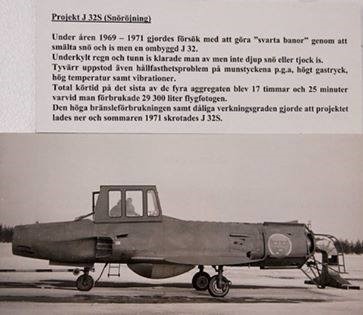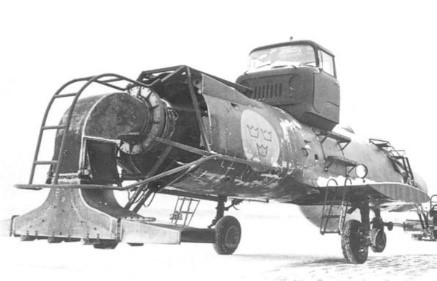Sonic bangs and snowdrifts
The sound barrier – Mach 1
As the speed of military aircraft continually increased, so these aircraft rapidly approached the speed of sound. When the speed got closer, a number of changes took place, including an increase in air resistance and a change in the effect of the rudder and elevators, so much that the speed of sound came to be regarded as a veritable wall. It seemed that available traditional technology would be unable to get through this barrier.
Sound travels at different speeds through different media, but the one most often meant when referring to the speed of sound is air. At 15°C sound travels at 1224 kilometres per hour (340 m/s) and this is the figure used when referring to an aircraft at the speed of sound. Now this is not the whole truth, because the speed of sound in air also depends on altitude. This is why a different concept is used, namely the Mach number, for an aircraft’s speed relative to sound. The higher the Mach number, the closer to the speed of sound. Mach 1.0 is reached when the aircraft is travelling at the speed of sound, whatever the altitude may be.
The stresses that an aircraft approaching the sound barrier may be subjected to led some people to believe that it would be impossible to go through the sound barrier and survive. It was known that the barrier could be broken, and an early example of an object doing so was the tip of a whiplash when it is cracked, making the bang because it is moving so fast. This is what is called a sonic bang. It may be small, but it really is a sonic bang. Consequently, would an aircraft going faster than sound cause a sonic bang, and if so what would then happen?
Knocking on the door
The first pilot to claim that he had broken the sound barrier was a German fighter pilot, Hans Guido Mutke, who said that he had broken the barrier in his Messerschmitt 262 jet fighter aircraft. However several of Mutke’s colleagues were very sceptical of his claim, and later German tests and experience after the War showed that even if the Messerschmitt 262 could reach a speed close to that of sound it was impossible to actually reach it. Despite this, Mutke to the last persisted in believing that he had broken the sound barrier.
Another German pilot, Heini Dittmar, who flew the Me 163 Komet rocket-powered aircraft did reach speeds that caused him to experience compression turbulence similar to that generated just before passing the barrier, and so Dittmar is considered to have been the first person to knock on the door of the barrier and survive. But a colleague of Dittmar, Lothar Sieber, may have been the first person to break the sound barrier on March 1st 1945 when he test flew the experimental Bachem Ba 349 Natter aircraft, which was an attempt to build an aircraft that would take off vertically, like a rocket. The flight lasted only 55 seconds but Sieber and his aircraft crashed. Sieber died and the Natter was totally destroyed. It could therefore never be established whether Sieber and his Natter really did go through the sound barrier.
Towards the end of the War the German V-2 rockets that were being used to bombard Britain regularly went through the sound barrier; but could a human do that and survive?
British researchers and designers succeeded in coming very close to the barrier and could well have been the first to break through it. Great Britain and the USA both tried to break the barrier and had an agreement to exchange information and data. Engineers in the American company Bell Aircraft received detailed information about the Miles M.52 British test aircraft that many considered to be very close to actually breaking through.
What ensued devastated the British. After the Americans got all the information concerning the British tests, they reneged on the agreement. The British received no information in exchange.
Then on October 14th 1947 the sound barrier was officially broken by a human. Charles “Chuck” Yeager sat at the controls of the Bell X-1 experimental aircraft that was in many ways similar to the Miles M.52. Chuck had named his aircraft “Glamorous Glennis” and it was rocket-powered, like the German Me-163.

Chuck Yeager poses in front of the Bell X-1 “Glamorous Glennis”. He was the first to break the sound barrier and survive. Photo: US Air Force
“Glamorous Glennis” was released from the bomb bay of a modified B-29 bomber and reached a speed of 1299 km/h or Mach 1.06. Yeager then landed the aircraft as usual.
To be the first to break the sound barrier had been loaded with prestige, to such an extent that two closely linked countries then went behind each other’s backs and misled each other. If the British had not handed over all their information they could have been the first. Or if the Americans had kept to the agreement perhaps the British would have been first anyway. This chicanery between allies does not however detract from paying homage to Charles ”Chuck” Yeager and his fellow test pilots. Chuck was the first to definitely break the sound barrier and be able to tell the story afterwards. Once it had been broken and it had been demonstrated that it did not result in the immediate death of the pilot, soon the whole world was engaged in getting through the sound barrier.
The first Swede to break the barrier
As previously mentioned, Sweden was investing heavily in aviation and the construction of a strong and modern air force. But it had neither the expertise nor resources to, unlike the major nations, to build special experimental aircraft with the sole aim of setting records and testing the outer limits. This didn’t stop Swedish pilots from, trying, however.
The Saab J29 Flying Barrel set several records but despite many attempts no-one managed to push the Barrel through the sound barrier. It was missing just that little extra and even in a dive could not reach the magic Mach 1.0.
The Barrel didn’t really have what it took to break the sound barrier, nor were there the resources to specifically reach this goal. Bur when Bengt Olow took off in the first prototype of the Saab 32 Lance there was a feeling that perhaps the Lance could achieve what the Barrel could not.
Now the Lance had not been designed with the aim that it should break the sound barrier, and sure enough it could not, in level flight. The RM5 engine could push the Lance close to that goal but not all the way. If only one could get a little extra.
It was the first Lance test pilot, Bengt Olow, who in the end reached the desired target. In 1953 he tipped the test aircraft into a shallow dive and rammed the throttle wide open. The result was the first sonic bang over Sweden to come from an aircraft and Bengt became the first Swede to break the sound barrier.
As a matter of interest we can add that Bengt Olow was also the first Swedish pilot to break the sound barrier in level flight, but this was in a different aircraft, namely the second prototype of the Saab 35 Draken (Kite).
Sonic bangs became more common when the Saab 35 Kite and later the Saab 37 Thunderbolt entered service. From being rather uncommon and frightening these became something that occasionally generated a lot of irritation and in some cases damage when the shock waves broke windows. Or shouts of delighted alarm from groups of curious children.
The strangest of all lances
Snow and ice are factors that can cause major problems for aviation, and the problems become greater the further north one goes. Northern Sweden is a strategically important area and the Swedish Air Force must ensure that it can operate in the north.
Between the wars and during the Second World War there were no squadrons based up in the north. There were air bases and depots but units arrived from more southerly squadrons that moved north as required. Therefore 21 Wing (F21) was established on Kallax heath outside Luleå. This became Sweden’s most northerly Air Force unit that battled with King Bore, the Winter King.
Long ago ice-covered lakes could make excellent air bases in wintertime and aircraft were equipped with skis. However after the Second World War it became clear that such improvised solutions belonged in the past. Modern aviation demanded well-constructed runways and these must be kept clear of snow and ice or anything else that could endanger aircraft when taking off or landing.
As Sweden’s most northerly Wing, F21 really was in the front line in respect of overcoming snow in winter. Snow cover of a metre or more was not at all unusual so that ploughing the runways was a frequently repeated exercise. Imagine if a solution could be found to reduce this amount of work. If one somehow could melt the snow and ice away by some mechanical means. The heat from jet aircraft engines obviously affected snow and ice locally, especially if an afterburner was switched on. Could this somehow be used for snow clearing?


During 1969 to 1971 attempts were made to obtain clear runways by melting snow and ice using rebuilt J 32 aircraft. It worked on freezing rain and thin ice, but not on deep snow or thick ice. Unfortunately there arose fastening problems at the nozzle due to high gas pressure, high temperature and vibration. The total running time for the four units was 17 hours 25 minutes, during which the consumption was 29,300 litres of aviation kerosene. The massive fuel consumption and poor efficiency led to the project being abandoned (“put on ice”- pun intended) and the J 32S was scrapped in the summer of 1971.
Obviously there was a lot of inventiveness at 21 Wing which resulted in possibly the strangest use of a jet engine ever. It also says something about how much air force equipment existed and how quickly an aircraft could be so obsolete that it could be utilised for other purposes.
In 1969 four of the Wing’s J32B aircraft were selected tor rebuilding into snow clearance machines. The wings and tail were cut off and a cabin built above the fuselage. At the engine tailpipe a square duct was attached that curved down to the ground. This directed the hot air coming from the engine downwards on to the snow and ice on the ground.
These four machines received the humorous designation J32S/J16, where “S” stood for snow and “J16” for half of a J32. This very strange version of the Saab 32 Lance was tested by 21 Wing between 1969 and 1971, when the project was abandoned. The efficiency was too poor and the fuel consumption too great. In addition there was a problem with the welding of the square duct. So the project ended and snow clearing continued using the more traditional methods. But a more strange use for a jet aircraft can hardly have arisen.
